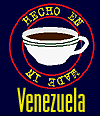
While standing in line the other day waiting to order what was really dessert more than just coffee, I realized that in the coffee shop craze that has swept over the United States recently, all kinds of coffee menu items have been invented. For the most part, they are just variations on world wide standards: espresso and milk, steamed or not, hot or cold. There isn't much more to it, really. Chocolate, syrups, cinnammon, and nutmeg are just additions to what is already a perfectly good cup of coffee.
Skipping past the additions, it struck me that most of the names for coffee/milk combinations are really a description of how the milk is prepared, and in what proportions it is going to join the one shot of espresso in your cup. Caffe au lait and caffe latte are so closely related that most people don't know the difference, but they do know that both have more steamed milk than a cappuccino. In many places you can get either, but not both, and the size of the cup reflects whether you get one, two, or three shots of espresso with your milk.
Even if you must have the drip kind of coffee known throughout most of the world as American coffee, it comes down to how much cream or milk is being added; "light", "very light", and "regular" are usually the descriptions heard at any Dunkin' Donuts. What that means is, of course, left up to whomever is actually adding the milk/cream to a very large cup of weak coffee.
The line for my mochaccino (I told you it, was dessert...) being quite long, I commented to the person I was with how in Venezuela, where I come from, names for coffee/milk variations mostly focus on the coffee part of the equation and how each has its own name and precise description, leaving little to interpretation. The first thing to know is that coffee is mostly served in small cups, sometimes called demitasse cups in North America. It is quite amusing to see the look of confusion on the faces of Venezuelans who are visiting the US for the first time and who haven't been warned about mugs as one is placed in front of them... A mug full of what Venezuelans (a good chunk of the world) call coffee would keep someone wired for days. When coffee is served in a container larger than that, it is a saucer with a dish, and there is most definitely milk in there. Mugs are, well, a US import of recent years, and the itsy bitsy spoons that are showing up in specialty shops in the US have been the norm in Venezuela for decades.
A couple of more things should be noted. Whether at a bakery (yes, people go there to get coffee; there are lots and lots of them, everywhere, but that's another story), a cafe, or elsewhere, Venezuelans usually drop the (to us) obvious "coffee" and order like thus: "dame un con leche, por favor," which literally means "give me one with milk, please". I say that so that when you hear "dame un negrito", you can rest assured all you are getting is a small cup of espresso, and there are no racial comments being made. (By the way, if you do venture into Venezuela to have coffee or otherwise, don't be surprised to hear someone call their significant other "negrito" or "negrita"; once again, it is nothing but a term of endearment, and skin color is irrelevant.) Also, coffee at home is made with espresso coffee makers. These are neither the industrial kind they have at bakeries, nor the espresso machines sold in specialty shops in the US, but the kind that you put over a stove. Basically, the definition of coffee there is that of an espresso.
But, on with the coffee naming conventions. "Negrito", which translates to "small black one", is basically a shot of espresso. It can be "largo" (long) or "corto" (short), which describes how strong the coffee is based on the pressure in which water is forced through the ground coffee. A "Con Leche" is 3/4 steamed milk (counting the foamy part of the milk in the measurement) and 1/4 coffee. A "Marron" (brown) is half coffee half steamed milk, while the balance shifts slightly one way or the other for "Marron claro" (light) or "Marron oscuro" (dark).
There are also the Guayoyo and the Guarapo, which are closer to American coffee, but are still served in small cups. The Guayoyo is brewed with the coffee grinds of the previous coffee, while a Guarapo is made with twice as much water (or half as much coffee), both resulting in a weaker brew.
A few regional names are also given to coffees around the country, while yet a few more are humorous and reflective of the characteristic Venezuelan wit, often describing the preparation of the brew or its temperature. A "Tetero", for example, translates literally to "baby's bottle", and is a "con leche" that has much too much milk, almost white. An "adequito" relates to the members of a political party, the "adecos", and it is meant to describe a "lazy" or weak coffee. "Como lengua de suegra" is literally "like a mother-in-law's tongue", meaning that the coffee is very hot. The list goes on...
One thing about coffee is confusing in Venezuela; there is a large population of Italians in the country, yet what we call a "capuchino" there is not what a capuccino is in Italy and the US. It is actually a "con leche" with whipped cream and cocoa or cinnamon on top. My understanding is that in the rest of the world that is known as "Viennese", and I have yet to find a coffee shop in the US that makes it.

